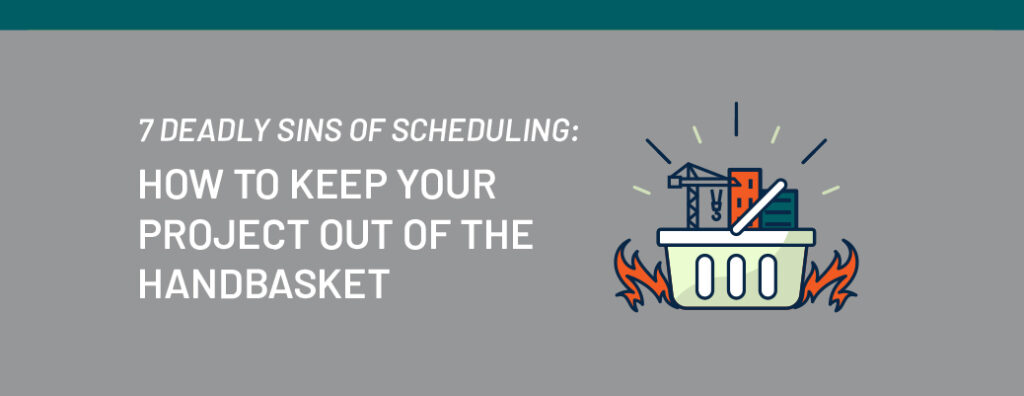
A schedule is intended to be used as a tool to allow project participants to proactively manage construction and adapt to changing circumstances as they arise. However, if a party’s intentions are not in the best interest of the project, the schedule loses its credibility as a management tool. While there may be thousands of activities in a schedule, and hundreds of days to build a project, we have identified schedule management actions in line with the seven deadly sins that can have your project “go to hell in a handbasket.”
Envy
Envy is a “resentful desire for another’s possessions or advantages.” In scheduling, envy often is expressed through project participants’ actions, not in accordance with the current project requirements, but rather based on their past enviable project(s). For example, rather than following the requirements in the specifications for development and maintenance of a CPM schedule, the project manager quips “On my last job…” or “When I started in construction, I didn’t have to do schedules.” However, without a project schedule in compliance with the specifications, how does a contractor effectively communicate its overall plan to execute and coordinate the project and, if necessary, justify time extension requests?
Gluttony
Gluttony is “an inordinate desire to consume more than which one requires.” On a construction project, gluttony is evident in schedules which are created with way too much detail. On most projects, the schedule does not need to have activities as detailed as “Install Electrical Receptacles, Room 136, North Wall” or “Install Landscaping, North Parking Lot, Northwest Island”. However, if you are developing a project schedule for a plant outage that is costing the company $1 million an hour in lost production, might an equivalent level of detail be appropriate?
Greed
Greed is “an overwhelming desire to acquire or have, as wealth or power, in excess of what one requires or deserves.” How does a project schedule allow a project participant to display greed? One example is front-loading the forecasted earnings in the schedule, wherein the work activities are assigned a budgeted value in excess of what the work is worth. This creates an issue should the original contract be terminated and the surety is required to complete the project.
On the owner’s side, the opposite end of the spectrum can show their own greed. When reviewing the activity status for a periodic progress update and progress payment, excessive scrutiny of progress on individual activities can be greedy. Is arguing over $1,000 on a $45 million project the best use of everyone’s time to achieve the goal of an on-time project completion?
Lust
How does lust impact the ability to use a schedule as a planning and management tool? Lust is “to have an intense or obsessive desire.” On certain projects, the specifications may require a full-time on-site scheduler whose sole duty is to maintain the project schedule.
On one such project, the contractor’s scheduler became obsessed with making modifications to schedule, most of which could not be supported by the actual performance of the contractor or other contemporaneous documentation. He just loved the schedule too much and this prevented the schedule from representing a realistic forecast of the contractor’s work and also made it extremely difficult for the contractor to justify delays during its performance.
Pride
Pride is an “excessive belief in one’s own abilities.” Similar to greed, finding persons on a construction project who are a bit overconfident in their abilities is not hard. For a contractor, their control of the construction means and methods can lead to a belief that they do not need to develop and manage a schedule. But should the contractor be impacted, not having a schedule can make it difficult to justify any delays.
Conversely, owners can attempt to counter this pride with their own. If an owner refuses to accept responsibility for delays on the project and forces the contractor to attempt to meet the contract completion date, it may create a constructive acceleration scenario for the contractor. In this situation, it is better for the project, and usually cheaper in the end, for the owner to contemporaneously resolve any time extension request and accept appropriate responsibility for delays.
Sloth
Sloth is an “aversion to exertion or work: laziness.” The simplest example of sloth is the effort a contractor makes to performing periodic schedule updates. Merely updating percent complete and allowing the software to determine the remaining duration for each activity may not accurately capture the true status of the project. For example, if an activity has an original duration of 10 workdays and is 80% complete, is the remaining duration realistically two workdays? What if it took the contractor 20 workdays to accomplish the 80% complete? Proper schedule management practices require updating the percent complete and remaining duration as two independent data points. This allows the contractor to accurately capture the actual progress and production achieved in the update period.
Wrath
Wrath is “violent, resentful anger.” Owners express wrath when rejecting a schedule submission for a tiny, non-impactful, non-compliance issue. Another example is using the contractor’s resource loading as a weapon, such as berating the contractor if actual staffing on site does not match the forecasted levels from the schedule, regardless of the progress achieved. From the contractor’s perspective, wrath is expressed by using the schedule as a weapon against their subcontractors or manipulating the schedule to force the critical path along a specific path solely to justify an alleged owner impact.
Conclusion
So, what can you do to keep your project out of the hand basket? We have identified these five tips to help keep you on the right path:
- Establish a realistic baseline schedule through a collaborative effort – Getting a realistic baseline schedule acceptable to both the contractor and owner, as early as possible in the project, is a key toward successful project execution. This establishes a basis from which to gauge progress, evaluate potential delays, and make informed decisions.
- Perform project schedule updates – With the baseline schedule established, performing accurate and timely periodic schedule updates helps the parties assess progress against the previous forecast, plan for and manage future construction and associated activities, as well as identify and help mitigate any potential project delays.
- Be flexible…remember this is construction – You will likely never see a project that is constructed exactly in accordance with the dates and sequence in the baseline schedule. Things happen – materials arrive early/late, a subcontractor is not available when needed, the owner makes a change, production is better/worse than anticipated, etc., etc. – but by using the baseline schedule and periodic updates as a tool, the parties can work through these typical occurrences and still achieve the project goal…on-time completion.
- Use the schedule as a management tool, not a weapon – This is the fundamental purpose of a schedule…to serve the project participants as a planning and management tool. It is not a weapon to use against another party. Once this occurs, the project is quickly on a slippery downward slope.
- Resolve time extensions contemporaneously – It is simple, do not wait. Do not resolve the direct cost component of a modification or impact and put off the resolution of the time component until the end of the project. This creates a significant liability for all parties, especially the project owner.
Download a copy of this blog here.




